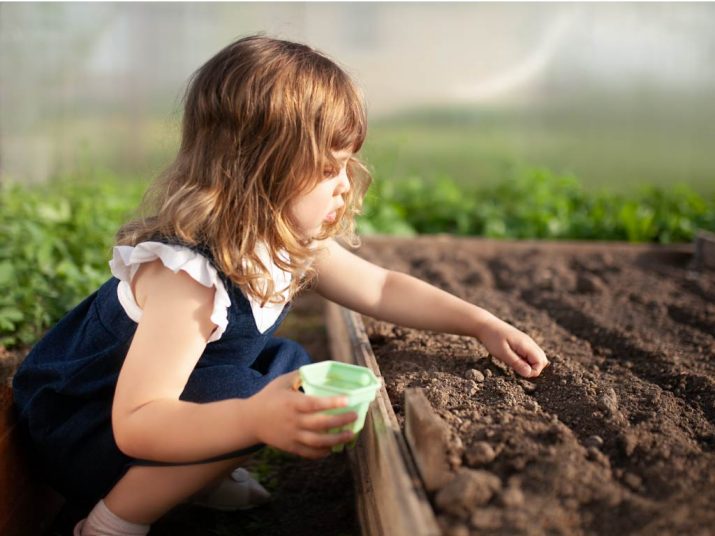
Ignite curiosity in little minds with these Earth Day science activities for kids! These STEM projects, experiments, and crafts make learning fun. Perfect for celebrating at home and supplementing school lessons, these ideas will help you explore our beautiful world. Earth Day is celebrated every April 22nd. It’s the perfect time to kick off your spring science lessons and encourage discovery. Science activities open a child’s mind to the wonders all around us. Try one of these hands-on Earth Day activities at home and feed a child’s curiosity!
5 Earth Day Science Activities for Kids
Rainbow in a jar kids’ science
Little scientists will love this easy rainbow-in-a-jar activity! With parent supervision, kids can pour their own rainbow in a jar and learn about density at the same time. To start, we recommend beginning with a lesson on density. Liquids are made up of molecules—some liquids have lots of molecules and some have very little. The ones with more molecules will be heavier and “sink” like a rock in water. After this explanation, it’s time to begin your kid-friendly science! For this activity you’ll need:
- Clear container, glass, or mason jar
- Honey
- Light corn syrup
- Dish soap (blue or green)
- Olive oil
- Rubbing alcohol
- Water
- Food coloring
- Dropper
Start by pouring the honey in the container. Make sure to pour it in the middle—don’t let it touch the sides. Next, color the corn syrup purple with food coloring and pour it in. Then pour in the dish soap. Add a layer of water tinted with food coloring (choose a color different from the dish soap). Add olive oil—make sure this layer is very thick. Finally, turn the rubbing alcohol red with food coloring and use the dropper to add in drops down the side of the container. Why use this method? If you pour in the rubbing alcohol too fast, it could break through the oil and pick up the blue food coloring you used for the water below. Once you’ve carefully added this last layer, your rainbow is done! Marvel in your masterpiece and admire its colors in the light.
Recycling STEM kit for kids
For this Earth Day activity, kids will learn about recycling and put on their engineering hats to make a toy robot! Before you start, discuss the important of recycling and how we recycle. Kids can practice recycling at home. Afterward, mention all the things that are made from recycled materials. Clothing, shoes, toys, and even toothbrushes can be made from recycled materials and plastics! Recycling reduces waste and pollution, making our Earth’s environment a cleaner and safer place to live.
Now it’s time to make your own recycled creation! Create a STEM kit by putting different objects into a plastic container. Include glue, clay, pencils, tissue paper, construction paper squares, googly eyes, glitter, plastic blocks, and more! Make sure it’s a random assortment of items. Kids will receive their STEM kit and try to create a robot from their surprise materials. By using old items to make something new, you are recycling and repurposing. This is an exciting hands-on Earth Day project that will spark a love of learning and discovery!
Plant seeds and help them grow
Learn about the life cycle of plants. Kids can plant flowers at home and care for them until they grow. Through this process, children can also learn about photosynthesis. Plants produce their own food through the process of photosynthesis. Plants draw up water through their roots, take in carbon dioxide from the air, and trap energy from sunlight. Plants then use that energy to turn water and carbon dioxide into sugars and oxygen. That oxygen is released into the air. So when you water a plant and give it plenty of sun, you are also helping life on Earth to receive more oxygen! Caring for plants is a fun and hands-on way to learn about helping the environment.
Layers of the Earth craft for kids
Make your own 3D model of the Earth that reveals its inner layers! The Earth is composed of distinct layers: the crust, the upper mantle, the lower mantle, the outer core, and the inner core. The inner core is a huge metal ball. Its temperature is so hot, it could melt metal but the core stays solid due to the surrounding pressure. The outermost layer, the crust, is the thinnest and made mostly from a rock called granite. This Earth Day craft activity lets kids make their own model to learn about the Earth’s layers. For this craft you’ll need:
- 5 colors of modeling clay (red, orange, green, purple and blue)
- Waxed dental floss
Form a ball from red clay to represent the inner core. Red represents its intense heat, as you learned above. Next, roll a layer of orange clay flat and wrap around the ball. Roll it gently to make sure the orange covers all of the red. Continue this process with the other colors. Make sure to use more clay for the first three layers and try to use less for the last layer—as the crust, it should be the thinnest layer. Once the ball is complete, use waxed dental floss to cut it in half and reveal the layers.
Oil spill clean-up experiment
Introduce kids to environmental science with this Earth Day experiment. Learn about the damaging effects of oil spills on our oceans and the best ways to stop oil from spreading to shorelines. For this experiment, you’ll need:
- Modelling clay
- Water
- Large glass container (ex. a cake pan)
- Cooking oil / olive oil
- Child’s toy
- Cheese cloth
- Dish soap
- Spoon
Inside a large glass container, create your environment. Children can mold clay to create the shoreline on either side. Pour water in the middle, which functions as your ocean. Pour 2 tablespoons of oil into the water to simulate an oil spill. The oil will slowly spread out in the water. Next, play the child’s toy into the oil and watch as the oil covers the toy. This demonstrates how animals like pelicans get caught in oil spills. Try rinsing the toy off with water—notice how it remains slippery. This didn’t get off all the oil. Try dish soap next to totally clean the toy. This is also how rescuers save animals.
For the next part of this science experiment, use different methods to clean up the oil spill. Use the cheese cloth to absorb the oil. Then, try the spoon to scoop out the oil. Finally, try dish soap to clean out the oil. Kids will discover that removal and absorption are the best methods to remove oil, and the method scientists use to help the environment. While the dish soap helps animals get clean, it isn’t as effective for removing oil in our oceans and adds more chemicals to the water.
Resources:
https://www.playdoughtoplato.com/rainbow-jar/
https://www.kitchencounterchronicle.com/oil-spill-clean-experiment-kids/
https://www.natgeokids.com/uk/discover/geography/physical-geography/structure-of-the-earth/
https://www.thechaosandtheclutter.com/archives/layers-earth-hands-science-activity


